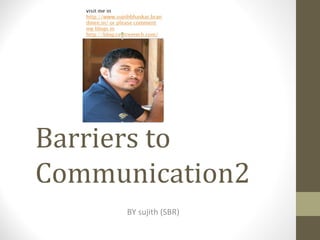
Barriers to Communication
- 1. Barriers to Communication2 BY sujith (SBR)
- 2. 1. Physical barriers Physical barriers in the workplace include: • marked out territories, empires and fiefdoms into which strangers are not allowed • closed office doors, barrier screens, separate areas for people of different status • large working areas or working in one unit that is physically separate from others.
- 3. • Research shows that one of the most important factors in building cohesive teams is proximity. As long as people still have a personal space that they can call their own, nearness to others aids communication because it helps us get to know one another.
- 4. 2. Perceptual barriers The following anecdote is a reminder of how our thoughts, assumptions and perceptions shape our own realities: A traveller was walking down a road when he met a man from the next town. "Excuse me," he said. "I am hoping to stay in the next town tonight. Can you tell me what the townspeople are like?" "Well," said the townsman, "how did you find the people in the last town you visited?" "Oh, they were an irascible bunch. Kept to themselves. Took me for a fool. Over-charged me for what I got. Gave me very poor service." "Well, then," said the townsman, "you'll find them pretty much the same here."
- 5. 3. Emotional barriers The emotional barrier is comprised mainly of fear, mistrust and suspicion. The roots of our emotional mistrust of others lie in our childhood and infancy when we were taught to be careful what we said to others. "Don't speak until you're spoken to"; "Children should be seen and not heard". As a result many people hold back from communicating their thoughts and feelings to others. They feel vulnerable. While some caution may be wise in certain relationships, excessive fear of what others might think of us can stunt our development as effective communicators and our ability to form meaningful relationships.
- 6. 4. Cultural barriers When we join a group and wish to remain in it, sooner or later we need to adopt the behaviour patterns of the group. These are the behaviours that the group accepts as signs of belonging. • The group rewards such behaviour through acts of recognition, approval and inclusion. In groups which are happy to accept you, and where you are happy to conform, there is a mutuality of interest and a high level of win-win contact. • Where, however, there are barriers to your membership of a group, a high level of game-playing replaces good communication.
- 7. 5. Language barriers Language that describes what we want to say in our terms may present barriers to others who are not familiar with our expressions, buzz-words and jargon. When we couch our communication in such language, it is a way of excluding others. In a global market place the greatest compliment we can pay another person is to talk in their language.
- 8. One of the more chilling memories of the Cold War was the threat by the Soviet leader Nikita Khruschev saying to the Americans at the United Nations: "We will bury you!" This was taken to mean a threat of nuclear annihilation.
- 9. However, a more accurate reading of Khruschev's words would have been: "We will overtake you!" meaning economic superiority. It was not just the language, but the fear and suspicion that the West had of the Soviet Union that led to the more alarmist and sinister interpretation.
- 10. 6. Gender barriers There are distinct differences between the speech patterns in a man and those in a woman. A woman speaks between 22,000 and 25,000 words a day whereas a man speaks between 7,000 and 10,000. In childhood, girls speak earlier than boys and at the age of three, have a vocabulary twice that of boys.
- 11. 6. Gender barriers The reason for this lies in the wiring of a man's and woman's brains. When a man talks, his speech is located in the left side of the brain. When a woman talks, the speech is located in both hemispheres.
- 12. This means that a man talks in a linear, logical and compartmentalised way, features of left-brain thinking; whereas a woman talks more freely mixing logic and emotion, features of both sides of the brain. It also explains why women talk for much longer than men each day.
- 13. 7. Interpersonal barriers There are six levels at which people can distance themselves from one another: Withdrawal is an absence of interpersonal contact. It is both refusal to be in touch and preference to spend time alone. Rituals are meaningless, repetitive routines devoid of real contact. Pastimes fill up time with others in social but superficial activities. Working activities are those tasks which follow the rules and procedures of contact but no more. Games are subtle, manipulative interactions which are about winning and losing. Closeness is the aim of interpersonal contact where there is a high level of honesty and acceptance of yourself and others.
- 14. Conclusion Working on improving your communications is a broad-brush activity. You have to change your thoughts, your feelings, and your physical connections. That way, you can break down the barriers that get in your way and start building relationships that really work.
- 15. Questions
